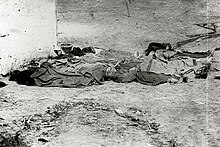Calle de los Negros
| Chinese massacre of 1871 | |
|---|---|

Corpses of Chinese immigrants who were murdered during the massacre
|
|
| Location | Los Angeles, California, U.S. |
| Coordinates | 34°03′43″N 118°14′17″W / 34.062°N 118.238°W |
| Date | October 24, 1871 |
| Target | Chinese immigrants |
|
Attack type
|
Massacre |
| Deaths | 17 to 20 |
| Perpetrators | Mob of around 500 white men |
| Motive | Racially motivated, revenge for killing Robert Thompson, a local rancher |
The Chinese massacre of 1871 was a racially motivated riot which occurred on October 24, 1871 in Los Angeles, California, when a mob of around 500 people entered Chinatown to attack, rob, and murder Chinese residents of the city. The massacre took place on Calle de los Negros (Street of the Negroes), also referred to as "Nigger Alley", which later became part of Los Angeles Street. An estimated 17 to 20 Chinese immigrants were tortured and then hanged by the mob, making the event the largest mass lynching in American history.
The riot and massacre were allegedly triggered by the killing of Robert Thompson, a local rancher, who was caught in the cross-fire during a gun battle between two Chinese factions. This fight was part of a longstanding feud over the abduction of a Chinese woman named Yut Ho.
The dead Chinese in Los Angeles were hanging at three places near the heart of the downtown business section of the city; from the wooden awning over the sidewalk in front of a carriage shop; from the sides of two “prairie schooners” parked on the street around the corner from the carriage shop; and from the cross-beam of a wide gate leading into a lumberyard a few blocks away from the other two locations. One of the victims was hanged without his trousers and minus a finger on his left hand.
Practically every Chinese-occupied building on the block was ransacked and almost every resident was attacked or robbed. A total of 18 Chinese immigrants were tortured and then hanged by the mob, making the event the largest mass lynching in American history.
Calle de los Negros was situated immediately northeast of Los Angeles’s principal business district, running 500 feet (150 m) from the intersection of Arcadia Street to the plaza. The unpaved street took its name from the Californios (pre-annexation, Spanish-speaking Californians) of darker-complexion (most likely of mixed race: Spanish and Native American) who had originally lived there. Once home to the town’s most prominent families, the neighborhood had deteriorated into a slum by the time Los Angeles’s first Chinatown was established there in the 1860s.
...
Wikipedia
